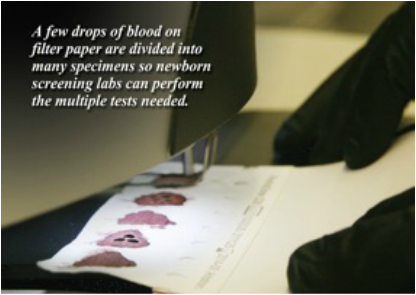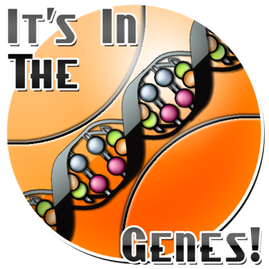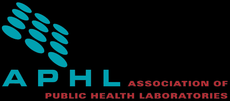It's Genetics, Baby!
 The Newborn Screening Story - Source: APHL
The Newborn Screening Story - Source: APHL
Screening of newborns for certain life threatening genetic deficiencies is another important facet of public health where public health laboratory scientists play a critical role by using a combination of laboratory procedures. This remains the largest and most successful public health promotion and disease prevention system in the country and perhaps the fastest, safest way to help protect babies. A few drops of blood from the baby’s heel is placed on a special piece of paper and tested by public health laboratory scientists using various biochemical and analytical procedures. Some examples of conditions screened for include cystic fibrosis, congenital hypothyroidism and sickle cell anemia.
Newborn screening, of around 4 million babies annually, allows those with these deficiencies to be identified and treated before they get sick, preventing serious illness or death. In the US, PHL scientists help save the lives of more than 12,000 babies every year!
Public health laboratory scientists play a vital role in genetic testing by using a combination of laboratory procedures to determine if an individual has a gene or multiple genes that may adversely affect their health. An example is newborn screening, which is the largest and most successful public health promotion and disease prevention system in the country and perhaps the fastest, safest way to help protect babies against diseases and medical conditions. Nearly all of the 4 million babies born annually in the US receive newborn screening from public health laboratories. The screening is performed by pricking the baby's heel to collect a few drops of blood either 24 or 48 hours after the baby is born. The blood is placed on a special piece of paper and sent to a public health laboratory for analysis. Scientists use numerous biochemical and analytical procedures and instrumentation to screen the blood sample for certain genetic, endocrine and metabolic disorders.
Examples of newborn screening conditions are Medium Chain Acyl-CoA Dehydrogenase (MCAD) Deficiency-- a disease that results in the build-up of fatty acids in the body and can lead to brain damage and breathing problems; cystic fibrosis—a disease that affects the lungs, pancreas and digestive system; congenital hypothyroidism—a disease in which infants are missing their thyroid gland or do not produce enough of a particular thyroid hormone which stimulates growth and brain development; and sickle cell anemia—a disease in which the red blood cells have an abnormal shape reducing their ability to carry oxygen throughout the body. Newborn screening allows for babies with these diseases to be identified and treated, oftentimes before they get sick, preventing serious health problems or even death. In the US, more than 12,000 newborn lives are saved or improved through newborn screening every year by public health laboratory scientists!
Newborn screening, of around 4 million babies annually, allows those with these deficiencies to be identified and treated before they get sick, preventing serious illness or death. In the US, PHL scientists help save the lives of more than 12,000 babies every year!
Public health laboratory scientists play a vital role in genetic testing by using a combination of laboratory procedures to determine if an individual has a gene or multiple genes that may adversely affect their health. An example is newborn screening, which is the largest and most successful public health promotion and disease prevention system in the country and perhaps the fastest, safest way to help protect babies against diseases and medical conditions. Nearly all of the 4 million babies born annually in the US receive newborn screening from public health laboratories. The screening is performed by pricking the baby's heel to collect a few drops of blood either 24 or 48 hours after the baby is born. The blood is placed on a special piece of paper and sent to a public health laboratory for analysis. Scientists use numerous biochemical and analytical procedures and instrumentation to screen the blood sample for certain genetic, endocrine and metabolic disorders.
Examples of newborn screening conditions are Medium Chain Acyl-CoA Dehydrogenase (MCAD) Deficiency-- a disease that results in the build-up of fatty acids in the body and can lead to brain damage and breathing problems; cystic fibrosis—a disease that affects the lungs, pancreas and digestive system; congenital hypothyroidism—a disease in which infants are missing their thyroid gland or do not produce enough of a particular thyroid hormone which stimulates growth and brain development; and sickle cell anemia—a disease in which the red blood cells have an abnormal shape reducing their ability to carry oxygen throughout the body. Newborn screening allows for babies with these diseases to be identified and treated, oftentimes before they get sick, preventing serious health problems or even death. In the US, more than 12,000 newborn lives are saved or improved through newborn screening every year by public health laboratory scientists!
RESOURCES
Lesson Plans & Experiments
Should Newborn Screening Be Standardized?
- Students learn about newborn screening and the need to standardize tests across the US via a 7th grade lesson plan related to how decisions are made about testing (second link is an audio file).
- http://www.learnnc.org/lp/external/5615?ref=search
- http://sciencenetlinks.com/science-news/science-updates/newborn-screening
Banana DNA
Have your DNA & Eat It, Too (PDF)
Extract Your Own DNA
- Students learn about DNA and various lab applications by extracting DNA from bananas. Public health laboratory scientists use a similar lab concept to extract genetic material (DNA) for analysis.
- https://migrc.org/TeachersAndStudents/BananaDNAExtraction.html
Have your DNA & Eat It, Too (PDF)
- This is a fun and engaging experiment teaching the rules of base pairing by having students build an edible model of DNA. See Lesson Plan: Teacher Guide: Have Your DNA and Eat It,
- http://teach.genetics.utah.edu/content/begin/dna/HaveYourDNAandEatItToo.pdf
Extract Your Own DNA
- Students learn that DNA is the blueprint for life and you can extract DNA from practically
- http://www.pbs.org/wgbh/nova/body/extract-your-
- http://learn.genetics.utah.edu/content/labs/extraction/howto/
Games & Apps
DNA Mutation Activity for Cystic Fibrosis
Sequence DNA for Yourself
- This site includes an activity that teaches students about the gene mutations known to cause cystic fibrosis and how genetic variation can occur in a single gene.
- https://migrc.org/TeachersAndStudents/GeneticVariation.html
Sequence DNA for Yourself
- This animated interactive shows step-by-step how researchers determine the sequence of A's, G's, C's, and T's that comprise DNA.
- http://www.pbs.org/wgbh/nova/body/sequence-DNA-for-yourself.html
Videos
“The Twisting Tale of DNA” - Judith Hauck (TEDEd)
- This video explains the basic science of DNA gene sequencing and how environmental factors have a role in gene mutations.
- http://ed.ted.com/lessons/the-twisting-tale-of-dna-judith-hauck
Genetics Rap
Newborn Screening Process
Newborn Screening Virtual Lab Tour Video
Bubble Boy Disease
- This is a short video to help teachers engage students on the topic of
- http://www.teachertube.com/video/genetics-rap-195326
Newborn Screening Process
- This is a video (16:50) that shows the entire newborn screening process beginning with the Texas Public Health State Laboratory, treatment at Mt. Sinai, NY and examples of small babies with various disorders, including a missed case from Virginia and disorders tested by different states.
- https://www.youtube.com/watch?v=uu2C2oS0YtI
Newborn Screening Virtual Lab Tour Video
- This is a short virtual tour of the Newborn Screening Ontario laboratory that covers the testing steps from sample collection to testing by public health laboratory scientists.
- https://www.youtube.com/watch?v=p0dMpv9WUhk&feature=youtu.be
Bubble Boy Disease
- Severe combined immunodeficiency (SCID) disease, one of the disorders screened by public health laboratory scientists, is also called the Bubble Boy Disease. These short videos provide a glimpse into the disease, diagnosis, treatment, hereditary traits and the life of the original Bubble Boy.
- https://www.youtube.com/watch?v=35MgqYuEQ5A
- https://www.youtube.com/watch?v=BgesL8cVgmI
- https://www.youtube.com/watch?v=4CFPdUAj41Y
If you want to know more...
- Newborn screening history from a public health laboratory scientist’s point of view and an overview of the Wisconsin State Laboratory of Hygiene.
- This site provides the list of genetic conditions each state screens for as part of its public health newborn screening program.
- New England Consortium of Metabolic Programs, “An Educator's Resource Guide to PKU” PDF booklet (12
Have questions or feedback? Contact us at [email protected].






